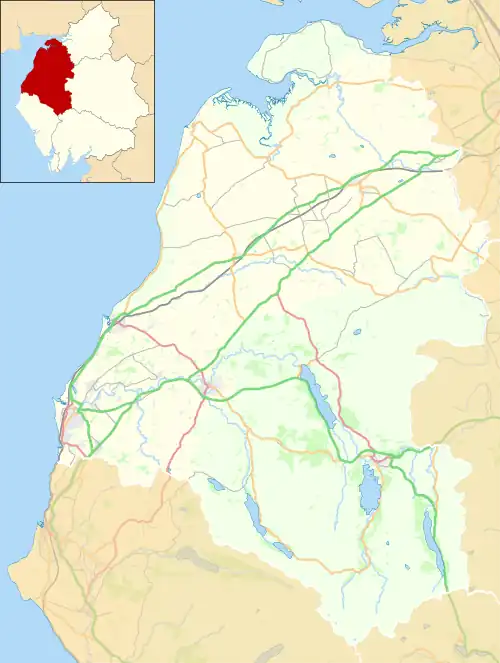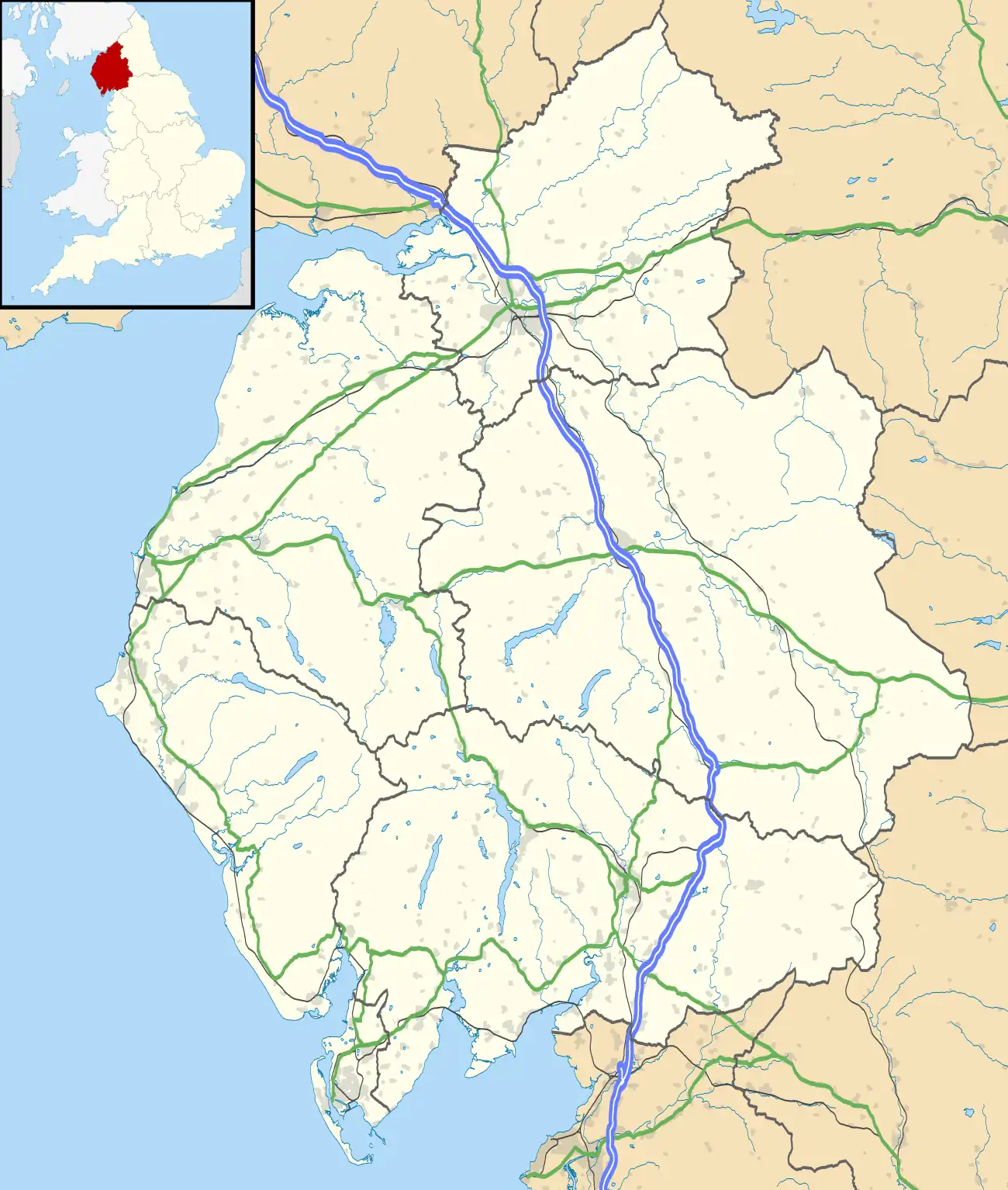Great Broughton | |
|---|---|
| General information | |
| Location | Great Broughton, near Cockermouth, Cumberland England |
| Coordinates | 54°40′29″N 3°26′45″W / 54.6748°N 3.4459°W |
| Grid reference | NY068320 |
| Platforms | 1[1] |
| Other information | |
| Status | Disused |
| History | |
| Original company | Cleator and Workington Junction Railway |
| Key dates | |
| 4 January 1888 | Opened |
| July 1897 | Closed |
| 1 September 1908 | Opened |
| 1 November 1908 | Closed to passengers[2] |
| 1 September 1921 | Closed completely[3] |
| Location | |

Cleator & Workington Junction Rly | |||||||||||||||||||||||||||||||||||||||||||||||||||||||||||||||||||||||||||||||||||||||||||||||||||||||||||||||||||||||||||||||||||||||||||||||||||||||||||||||||||||||||||||||||||||||||||||||||||||||||||||||||||||||||||||||||||||||||||||||||||||||||||||||||||||||||||||||||||||||||||||||||||||||||||||||||||||||||
|---|---|---|---|---|---|---|---|---|---|---|---|---|---|---|---|---|---|---|---|---|---|---|---|---|---|---|---|---|---|---|---|---|---|---|---|---|---|---|---|---|---|---|---|---|---|---|---|---|---|---|---|---|---|---|---|---|---|---|---|---|---|---|---|---|---|---|---|---|---|---|---|---|---|---|---|---|---|---|---|---|---|---|---|---|---|---|---|---|---|---|---|---|---|---|---|---|---|---|---|---|---|---|---|---|---|---|---|---|---|---|---|---|---|---|---|---|---|---|---|---|---|---|---|---|---|---|---|---|---|---|---|---|---|---|---|---|---|---|---|---|---|---|---|---|---|---|---|---|---|---|---|---|---|---|---|---|---|---|---|---|---|---|---|---|---|---|---|---|---|---|---|---|---|---|---|---|---|---|---|---|---|---|---|---|---|---|---|---|---|---|---|---|---|---|---|---|---|---|---|---|---|---|---|---|---|---|---|---|---|---|---|---|---|---|---|---|---|---|---|---|---|---|---|---|---|---|---|---|---|---|---|---|---|---|---|---|---|---|---|---|---|---|---|---|---|---|---|---|---|---|---|---|---|---|---|---|---|---|---|---|---|---|---|---|---|---|---|---|---|---|---|---|---|---|---|---|---|---|---|---|---|---|---|---|---|---|---|---|---|---|---|---|---|---|---|---|---|---|---|---|---|---|---|---|---|---|---|---|---|---|---|---|---|
| |||||||||||||||||||||||||||||||||||||||||||||||||||||||||||||||||||||||||||||||||||||||||||||||||||||||||||||||||||||||||||||||||||||||||||||||||||||||||||||||||||||||||||||||||||||||||||||||||||||||||||||||||||||||||||||||||||||||||||||||||||||||||||||||||||||||||||||||||||||||||||||||||||||||||||||||||||||||||
Maryport and Carlisle Railway | |||||||||||||||||||||||||||||||||||||||||||||||||||||||||||||||||||||||||||||||||||||||||||||||||||||||||||||||||||||||||||||||||||||||||||||||||||||||||||||||||||||||||||||||||||||||||||||||||||||||||||||||||||||||||||||||||||||||||||||||||||||||
|---|---|---|---|---|---|---|---|---|---|---|---|---|---|---|---|---|---|---|---|---|---|---|---|---|---|---|---|---|---|---|---|---|---|---|---|---|---|---|---|---|---|---|---|---|---|---|---|---|---|---|---|---|---|---|---|---|---|---|---|---|---|---|---|---|---|---|---|---|---|---|---|---|---|---|---|---|---|---|---|---|---|---|---|---|---|---|---|---|---|---|---|---|---|---|---|---|---|---|---|---|---|---|---|---|---|---|---|---|---|---|---|---|---|---|---|---|---|---|---|---|---|---|---|---|---|---|---|---|---|---|---|---|---|---|---|---|---|---|---|---|---|---|---|---|---|---|---|---|---|---|---|---|---|---|---|---|---|---|---|---|---|---|---|---|---|---|---|---|---|---|---|---|---|---|---|---|---|---|---|---|---|---|---|---|---|---|---|---|---|---|---|---|---|---|---|---|---|---|---|---|---|---|---|---|---|---|---|---|---|---|---|---|---|---|---|---|---|---|---|---|---|---|---|---|---|---|---|---|---|---|---|---|---|---|---|---|---|---|---|---|---|---|---|---|---|---|---|
| |||||||||||||||||||||||||||||||||||||||||||||||||||||||||||||||||||||||||||||||||||||||||||||||||||||||||||||||||||||||||||||||||||||||||||||||||||||||||||||||||||||||||||||||||||||||||||||||||||||||||||||||||||||||||||||||||||||||||||||||||||||||
Great Broughton railway station briefly served the village of Great Broughton, near Cockermouth in Cumberland (now in Cumbria), England.[4][5][6]
The station was opened by the Cleator and Workington Junction Railway (C&WJR) on 1 September 1908 on its "Northern Extension" from Calva Junction on the northern edge of Workington to the Maryport and Carlisle Railway's Derwent Branch at Linefoot. The C&WJR built this 7 miles 30 chains (11.9 km) line to connect the C&WJR with Carlisle and beyond. The line was double track from Workington to Seaton, then single through Great Broughton to Linefoot.
Most stations on C&WJR lines had heavy industrial neighbours, such as ironworks next to Cleator Moor West, or served primarily industrial workforces, such as Keekle Colliers' Platform. Great Broughton, however, was a fairly isolated country village, though there were small collieries nearby.
History
The C&WJR was built in the late 1870s, being one of the fruits of the rapid industrialisation of West Cumberland in the second half of the nineteenth century, specifically being born as a reaction to oligopolistic behaviour by the London and North Western and Whitehaven, Cleator and Egremont Railways.[7]
It was originally intended to drive the line northwards across country to meet the Caledonian Railway and cross into Scotland by the Solway Viaduct, but an accommodation was made with the LNWR leading to the intended northern extension being greatly watered down to three lines:
- a 1 mile 54 chains (2.7 km) link from Workington Central to Siddick Junction which opened in 1880
- a 30 chains (0.60 km) link from Cloffocks Junction to the CKPR line which opened in March 1885, and
- the "Northern Extension" through Great Broughton to Linefoot.[8]
All lines in the area were primarily aimed at mineral traffic, notably iron ore, coal and limestone, none more so than the Northern Extension, which passed through open country. Passenger services were provided calling at Great Broughton, but they were so unsuccessful they petered out after a mere two months. The C&WJR earned the local name "The Track of the Ironmasters".[9]
The founding Act of Parliament of June 1878 confirmed the company's agreement with the Furness Railway that the latter would operate the line for one third of the receipts.[10]
All C&WJR's lines were heavily graded. Almost all of the first three miles of the Northern Extension from Calva Junction through Seaton was rising at 1 in 70, with gentler slopes thereafter to the extension's summit at Great Broughton[11] This favoured loaded coal and coke trains heading for Workington..
The Northern Extension became part of the London, Midland and Scottish Railway at the Grouping of 1923.
Like any business tied to one or few industries, the C&WJR was particularly at the mercy of trade fluctuations and technological change. The Cumberland iron industry led the charge in the nineteenth century, but became less and less competitive as time passed and local ore became worked out and harder to win, taking the fortunes of the railway with it. The peak year was 1909, when the C&WJR handled 1,644,514 tons of freight.[12] Ominously for the line, that tonnage was down to just over 800,000 by 1922, bringing receipts of £83,349, compared with passenger fares totalling £6,570.[13]
The high water mark for tonnage on the C&WJR was 1909, the high water mark for progress was 1913, with the opening of the Harrington and Lowca line for passenger traffic. A chronology of the line's affairs from 1876 to 1992 has almost no entries before 1914 which fail to include "opened" or "commenced". After 1918 the position was reversed, when the litany of step-by-step closures and withdrawals was relieved only by a control cabin and a signalbox being erected at Harrington Junction in 1919.
Services
C&WJR passenger trains consisted of antiquated Furness stock hauled largely by elderly Furness engines[14][15] referred to as "rolling ruins" by one author after a footplate ride in 1949.[16]
No Sunday passenger service was ever provided on any C&WJR line.
The Northern Extension had three stations: Seaton, Great Broughton and Linefoot, the last being run jointly with the Maryport and Carlisle Railway (MCR). A passenger service was provided to Seaton over two periods: 1888 to 1897 and 1907 to 1922. The service in the first period appears to have been out and back over the 2 miles 19 chains (3.6 km) to Workington Central. This was reduced to Wednesdays and Saturdays only (Workington Market Days) from March 1891 and to Saturdays only from January 1894, being withdrawn completely in July 1897.[3][17]
The company tried again ten years later, with what appears to have been another daily out and back from Workington Central. From 1 September 1908 this was extended, on Saturdays only, to Great Broughton and Linefoot, making those outposts qualify as stations having had a publicly advertised passenger service. That experiment failed, as they disappeared from the timetable in December of that year, leaving Seaton as the only Northern extension station with a public passenger service. Both Great Broughton and Linefoot stations remained open for goods traffic.
The W&CJR ran many workmen's trains. Three collieries were served by the Northern Extension - Camerton, Buckhill and Alice Pit. No source lists any station, halt or workmen's service to this last, which was at the northern end of the line near Linefoot Junction. The 1920 Working Time Table lists Alice Pit, but shows no booked services of any description.
Camerton Colliery Halt and Buckhill Colliery Halt both had workmen's services at some point,[18] but they are not mentioned in the May 1920 Working Time Table. Indeed, Camerton Colliery is not mentioned at all.[19]
The 1920 Working Time Table shows no Goods (as opposed to mineral) trains or "Through goods" trains booked to call at or pass Great Broughton in either direction.[19]
Rundown and closure
The West Cumberland iron and steel industry was heavily dependent on supplies of coke from the Northumberland and Durham coalfields. The Northern Extension allowed "a large proportion" of this traffic to be routed away from Maryport and the coastal line. Likewise the short chord between Workington Bridge and Cloffocks Junction allowed Durham coke traffic to reach the furnaces via Cockermouth then the C&WJR.[20] These must have suffered a significant decline, as by 1920 there were just two booked mineral workings each way each weekday between Linefoot and Workington through Great Broughton.[19] It is therefore no surprise that the line north of Buckhill Colliery closed on 1 September 1921, closing Great Broughton and its residual goods traffic with it.[8]
The final stationmaster at Great Broughton was Joseph W Allason who retired, aged 78, on closure of the station after 42 years service.[21]
Afterlife
The trtack was lifted before the Second World War. By 2013 the trackbed through the station site could be traced on satellite images.
| Preceding station | Disused railways | Following station | ||
|---|---|---|---|---|
| Buckhill Colliery Halt Line and station closed |
Cleator and Workington Junction Railway Northern Extension |
Linefoot Line and station closed |
See also
References
- ↑ McGowan Gradon 2004, p. 63.
- ↑ Butt 1995, p. 108.
- 1 2 McGowan Gradon 2004, p. 68.
- ↑ McGowan Gradon 2004, pp. 6 & 63.
- ↑ Smith & Turner 2012, Map 26.
- ↑ Jowett 1989, Map 36.
- ↑ Anderson 2002, p. 309.
- 1 2 McGowan Gradon 2004, p. 59.
- ↑ Anderson 2002, p. 313.
- ↑ Marshall 1981, p. 117.
- ↑ McGowan Gradon 2004, p. 64.
- ↑ McGowan Gradon 2004, p. 50.
- ↑ Suggitt 2008, p. 65.
- ↑ Anderson 2002, p. 314.
- ↑ McGowan Gradon 2004, pp. 40 & 42.
- ↑ McGowan Gradon 2004, p. 51.
- ↑ Butt 1995, p. 207.
- ↑ Croughton, Kidner & Young 1982, pp. 55 & 53.
- 1 2 3 Haynes 1920, Tables.
- ↑ McGowan Gradon 2004, p.11, Note 8.
- ↑ McGowan Gradon 2004, p. 69.
Sources
- Anderson, Paul (April 2002). Hawkins, Chris (ed.). "Dog in the Manger? The Track of the Ironmasters". British Railways Illustrated. Clophill: Irwell Press Ltd. 11 (7). ISSN 0961-8244.
- Butt, R. V. J. (October 1995). The Directory of Railway Stations: details every public and private passenger station, halt, platform and stopping place, past and present (1st ed.). Sparkford: Patrick Stephens Ltd. ISBN 978-1-85260-508-7. OCLC 60251199. OL 11956311M.
- Croughton, Godfrey; Kidner, R. W.; Young, Alan (1982). Private and Untimetabled Railway Stations, Halts and Stopping Places. The Oakwood Press. ISBN 978-0-85361-281-0. OCLC 10507501.
- Jowett, Alan (March 1989). Jowett's Railway Atlas of Great Britain and Ireland: From Pre-Grouping to the Present Day (1st ed.). Sparkford: Patrick Stephens Ltd. ISBN 978-1-85260-086-0. OCLC 22311137.
- Haynes, Jas. A. (April 1920). Cleator & Workington Junction Railway Working Time Table. Central Station, Workington: Cleator and Workington Junction Railway.
- McGowan Gradon, W. (2004) [1952]. The Track of the Ironmasters: A History of the Cleator and Workington Junction Railway. Grange-over-Sands: Cumbrian Railways Association. ISBN 978-0-9540232-2-5.
- Marshall, John (1981). Forgotten Railways: North West England. Newton Abbot: David & Charles. ISBN 978-0-7153-8003-1.
- Smith, Paul; Turner, Keith (2012). Railway Atlas Then and Now. Ian Allan Publishing. ISBN 978-0-7110-3695-6.
- Suggitt, Gordon (2008). Lost Railways of Cumbria (Railway Series). Newbury, Berkshire: Countryside Books. ISBN 978-1-84674-107-4.
Further reading
- Conolly, W. Philip (1998). British railways pre-grouping atlas and gazetteer (9th impression; 5th ed.). Shepperton: Ian Allan. ISBN 978-0-7110-0320-0. OCLC 221481275.
- Atterbury, Paul (2009). Along Lost Lines. Newton Abbot: David & Charles. ISBN 978-0-7153-2706-7.
- Bairstow, Martin (1995). Railways In The Lake District. Leeds: Martin Bairstow. ISBN 978-1-871944-11-2.
- Bowtell, Harold D. (1989). Rails through Lakeland: An Illustrated Journey of the Workington-Cockermouth-Keswick-Penrith Railway 1847–1972. Wyre: Silverling Publishing Ltd. ISBN 978-0-947971-26-7.
- Joy, David (1983). Lake Counties (Regional History of the Railways of Great Britain). Newton Abbot: David & Charles. ISBN 978-0-946537-02-0.
- Robinson, Peter W. (2002). Cumbria's Lost Railways. Catrine: Stenlake Publishing. ISBN 978-1-84033-205-6.
- Webb, David R. (September 1964). Cooke, B.W.C. (ed.). "Between the Solway and Sellafield: Part One". The Railway Magazine. London: Tothill Press Limited. 110 (761). ISSN 0033-8923.
- Webb, David R. (October 1964). Cooke, B.W.C. (ed.). "Between the Solway and Sellafield: Part Two". The Railway Magazine. London: Tothill Press Limited. 110 (762). ISSN 0033-8923.
- Western, Robert (2001). The Cockermouth, Keswick and Penrith Railway. Usk: Oakwood Press. ISBN 978-0-85361-564-4. OL113.
External links
- Map of the CWJR with photos RAILSCOT
- Map of the WC&ER with photos RAILSCOT
- The station Rail Map Online
- The station on overlain OS maps surveyed from 1898 National Library of Scotland
- The trackbed through the station site on a 1948 OS Map npe maps
- The station and line railwaycodes
- The railways of Cumbria Cumbrian Railways Association
- Photos of Cumbrian railways Cumbrian Railways Association
- The railways of Cumbria Railways_of_Cumbria
- Cumbrian Industrial History Cumbria Industrial History Society
- A video tour-de-force of the region's closed lines cumbriafilmarchive
- 1882 RCH Diagram showing the station, see page 173 of the pdf google
- Photos of Calva Jct to Buckhill Tim Harris
- Photos of Siddick Junction - Calva - Broughton Moor derbysulzers
- Cycle Network at Seaton visitcumbria

